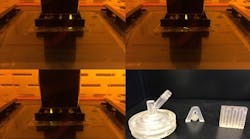A single-step three-dimensional (3D)-printing process that creates a chemically active catalytic object could lead to more efficient ways to produce catalysts for complex chemical reactions, say researchers at the U.S. Department of Energy’s Ames Laboratory, Ames, Iowa. They have produced via stereolithography catalysts suitable for a variety of chemical reactions involving organic chemicals. Post-processing makes possible multi-step reactions, they add.
Figure 1. One-step 3D-printing process for catalysts enables customizing them into any shape. Source: Igor Slowing, Ames Laboratory.
The researchers used an inexpensive commercial 3D printer. The structures are built using a laser targeting a bath of customized resins that polymerize and harden layer by layer.
“The monomers, or building blocks that we start with, are designed to be bifunctional. They react with light to harden into the three-dimensional structure, and still retain active sites for chemical reactions to occur,” explains Sebastián Manzano, a graduate student in the Department of Chemistry at Iowa State who conducted most of the experiments. More details appear in a recent article in ACS Catalysis.
The researchers simultaneously can control both the macroscale and nanoscale features — the shape of the structure itself, and the design of the catalyst, respectively. “This opens up many possibilities to rapidly produce structures custom designed to perform a variety of chemical conversions,” says Igor Slowing, a scientist in heterogeneous catalysis at Ames Laboratory who led the research.
“We consider 3D printing of catalytic structures advantageous for developing smart chemical systems, chemically active devices, and portable applications. It is the logical outcome of combining the structural versatility offered by 3D printing with the chemical versatility offered by functional groups,” he notes.
Using the approach, the team can directly produce acid, basic, and redox active functionalities. Postprinting transformations can provide functionalities that can’t be created directly, notes Slowing.
“Because the easiest monomer to work with is acrylic acid, you can use carboxylate groups as handles for post-printing chemical modifications,” he adds. “For example, you can use amine-containing molecules to introduce new groups via amide formation. In principle, you can use all the arsenal available in the well-developed area of solid-phase synthesis.”
Next, the team plans to investigate the effects of shapes, roughness and site distribution on the catalytic activity of 3D-printed materials. They also are exploring higher pressures and temperatures using different printing technologies; so far, materials have been tested up to 100°C and 5 bar pressure.
Depending on the final applications, the catalytic architecture can be rigid, soft, or even a 3D-printed active gel, notes Slowing. “Our first generation of active prints weren’t tolerant to some solvents; however, we have developed strategies to solve those problems, and keep exploring different ways to maximize the resistance of our materials. Ultimately, many of the catalytic architectures we have developed can be recycled many times without any apparent loss in activity.”
One limitation to performance is that the active layer is restricted to about 100 microns, says Slowing. “We have a couple of strategies that seem to already be giving more accessible surface and higher activity per mass of print. With some patience, we will see many new developments coming.”
Besides stereolithography, many other techniques can be used, notes Slowing. “…All of them, like stereolithography, are very far from having reached their full potential,” he believes.
“We are aware of a couple of large companies that are interested in exploring the area, and are hoping to establish some collaborations with them,” Slowing adds.
